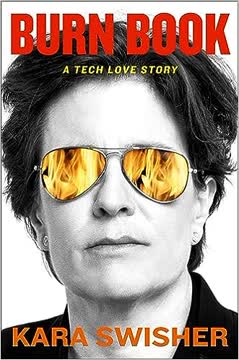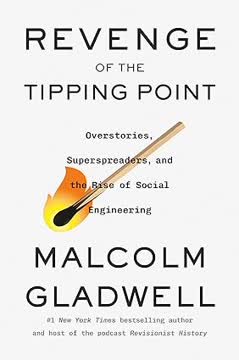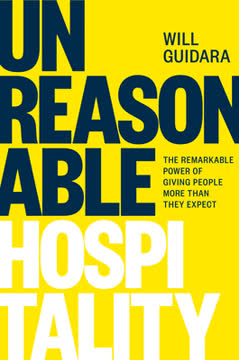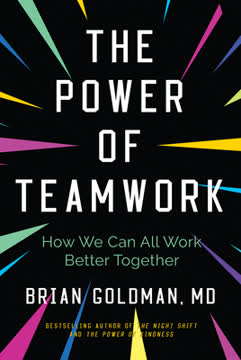Key Takeaways
1. A Group Is Not a Team: Interdependence and Shared Goals Define True Teamwork
To be a team, these individuals must be interdependent in terms of knowledge, abilities and the materials they work with.
Defining true teams. Many believe they work in teams simply because they work in groups, but the distinction is crucial. A group is merely a collection of individuals, whereas a true team is characterized by interdependence, where members rely on each other's unique skills and knowledge to achieve a common objective. Without this mutual reliance and a shared goal, even a collection of superstars can fail to perform as a cohesive unit.
Beyond individual talent. The power of a team lies in its ability to leverage individual talents, allowing members to complement one another and create an atmosphere where everyone can realize their true potential. In contrast, groups often foster competition for individual accolades, leading to insecurity and a reluctance to collaborate. This anti-teamwork cycle can stifle discussion, shut down ideas, and prevent collective achievement.
Shared mission is fundamental. Whether in sports, business, or healthcare, a team's success hinges on every member feeling joined in a common mission or struggle. When individuals prioritize personal gain over collective goals, the "whole" becomes less than the sum of its parts. True teamwork transforms individual efforts into a synergistic force, making the team far more successful than any single member could be alone.
2. Super-Efficiency: Teams Achieve More with Less Effort Through Neural Coordination
For the same level of work, the best brain surgeons are using much less of their brains because they’ve learned over time to activate only the areas they need to activate.
Neural efficiency in teams. Elite performers, whether surgeons or athletes, demonstrate "super-efficiency" by activating fewer brain areas for the same level of work, a concept known as neural efficiency. This principle extends to teams: as coordination, cohesion, and collective efficacy develop, teams achieve greater output with less individual effort, a "gain or a surplus in theory."
Shared and complementary knowledge. Teamwork thrives on a division of labor that aligns with both shared and complementary mental models. Just as jugglers coordinate their movements, or soccer players like Messi and Iniesta anticipate each other's actions, effective teams develop shared neural pathways while also activating complementary areas of the brain. This allows for seamless collaboration and optimized performance.
The coordination cost. While super-efficiency is the goal, forming a team incurs an initial "coordination cost." This involves the time and energy members invest in understanding each other's strengths, weaknesses, and roles. Studies, like one with FIFA 17 players, show this initial cost manifests as increased stress and brain activity. However, as teams practice and adapt, this cost becomes an investment, leading to an "economy of effort" where better results are achieved with less strain.
3. Psychological Safety and Flattened Hierarchies Unlock Collective Wisdom
I believe that true safety is an environment where everybody feels able to speak and share their truth and say what they see.
Safety fosters contribution. Psychological safety is paramount for effective teamwork, especially in fields like medicine where diagnostic accuracy is critical. When team members feel safe to voice observations, ask questions, and even admit uncertainty without fear of judgment or humiliation, it unlocks a richer, more accurate collective understanding of complex problems. This contrasts sharply with traditional hierarchical environments where junior members often remain silent.
Visual Thinking Strategies (VTS). Techniques like VTS, which uses art appreciation to teach critical thinking, exemplify how to cultivate this safety. By asking open-ended questions like "What is going on in the picture?" and "What makes you say that?", VTS encourages participants to:
- Engage in unbiased observation
- Justify their interpretations with evidence
- Explore multiple perspectives
- Tolerate diagnostic ambiguity
Flattening the hierarchy. Medical improv, through exercises like "Oscar Party" and "Yes, and," directly addresses hierarchical barriers. It teaches participants to recognize implicit status dynamics and to consciously adjust their communication style to empower others. This flexibility allows leaders to "lower their status" when appropriate, fostering an environment where every voice, regardless of rank, is heard and valued, leading to better decision-making and improved patient care.
4. Play to Learn: Games and Simulations Build Team Cohesion and Readiness
Wouldn’t it be great to use a ‘low stakes’ game to emulate something [teamwork] that’s really crucial in caring for patients?
Low stakes, high impact. Gamification and simulation offer powerful, low-stakes environments for developing crucial teamwork skills without the real-world consequences of failure. These methods allow professionals to practice complex scenarios, identify leadership voids, and build trust in a safe setting. This "in-situ" learning, where training occurs in the actual work environment, is particularly effective as it mirrors real-life conditions.
Escape rooms and board games. Commercial escape rooms, like "The Dig," simulate the time pressure and collaborative problem-solving needed in an emergency room, forcing participants to quickly form teams and delegate tasks. Similarly, board games like "Friday Night at the ER" and "GridlockED" teach hospital managers and healthcare professionals:
- Systems thinking and interdepartmental collaboration
- The impact of siloed decisions on overall efficiency
- Data-driven decision-making
- Creative problem-solving under pressure
Simulation training's realism. High-fidelity simulations, often using mannequins in actual hospital wards, immerse teams in realistic crisis scenarios like cardiac arrests. These exercises are invaluable for:
- Identifying latent safety threats (e.g., non-functional equipment, missing medications)
- Practicing communication and leadership skills
- Fostering multidisciplinary collaboration (doctors, nurses, RTs)
- Providing a safe space for making and learning from mistakes during debriefs
5. "See It, Say It": Aviation's Culture of Openness Prevents Catastrophe
Someone still has to be in charge, but the idea is that the information flows a lot more easily.
Crew Resource Management (CRM). Aviation's CRM principles, developed to reduce human error after a series of disasters, emphasize effective use of all available resources, including open communication and a flattened hierarchy. This "see it, say it" culture encourages every crew member, regardless of rank, to voice concerns or observations, ensuring critical information flows freely to the captain. This proactive approach to safety has dramatically reduced aviation fatalities.
Beyond the cockpit. CRM extends the team concept beyond the cockpit to include cabin crew, ground engineers, air traffic controllers, and even passengers. This broad inclusion ensures that potential threats are identified from multiple perspectives. For example, a passenger noticing an engine issue can report it to cabin crew, who then relay it to the pilot, demonstrating how a non-rigid hierarchy facilitates vital information exchange.
Lessons for healthcare. The tragic death of Elaine Bromiley, due to a "can't intubate, can't ventilate" scenario, highlights healthcare's historical lack of CRM. In her case, despite nurses recognizing the need for a surgical airway, their voices were not effectively heard in a rigid, implicit hierarchy. Aviation's success demonstrates that regular simulation training, pre-operative briefings, and a culture where junior members are empowered to challenge senior colleagues are crucial for preventing errors and fostering true teamwork in high-stakes medical environments.
6. Empathetic Leadership: Trust and Empowerment Drive Team Success
I think being a good listener is first and foremost. It’s about understanding others’ needs and priorities before imposing your own.
Leaders as catalysts. Effective leaders are not just decision-makers but catalysts for teamwork, fostering an environment of trust and empowerment. Chief Michael Nolan of Renfrew County paramedics exemplifies this by recruiting and training paramedics to expand their scope of practice, making them "Swiss Army knives" of healthcare. This empowers them to act as the "eyes and ears" for family doctors, building trust through demonstrated competence and shared responsibility.
Flattening the field. Nolan actively works to flatten the hierarchy between paramedics, doctors, and nurses, ensuring a "level playing field" where conversations flow freely. This involves:
- Paramedics performing advanced procedures (intubation, IVs, ultrasounds)
- Doctors trusting paramedic assessments and referrals
- Multidisciplinary collaboration on patient care plans
- Leaders articulating a vision that resonates with everyone's needs
Beyond the job description. True leadership extends beyond formal roles, encompassing emotional support and recognizing the human element in demanding situations. Trevor Jain, leading the Swissair 111 morgue operation, demonstrated this by ensuring the welfare of his troops, providing emotional support, and valuing every team member, including custodial staff. This empathetic approach builds deep loyalty and commitment, enabling teams to excel under extreme pressure.
7. The End User as Teammate: Integrating Patients and Customers for Better Outcomes
I don’t know the lived experience of the people I’m trying to serve, so I need them to lead.
Customer-centric teamwork. Astute leaders recognize that the "end user"—whether a patient, car owner, or news audience—is an integral part of the team. Dr. Carl Allamby, a former car mechanic turned ER physician, draws parallels between calming a flustered car owner and reassuring a distressed patient. His business success stemmed from including customers in the diagnostic and repair process, a lesson he now applies to medicine.
Journalism's revolution. Journalism, traditionally a top-down industry, is also embracing this model. Jennifer Brandel's Hearken platform empowers news organizations to engage audiences in story selection and reporting, transforming them from passive consumers into active partners. This "public-powered journalism" leads to:
- More original and nuanced stories
- Increased relevance and trust
- Higher audience engagement and donations
- A challenge to journalistic biases and assumptions
Overcoming paternalism. Both medicine and journalism have historically operated on a paternalistic model, where professionals assume they know best. However, recognizing the limitations of this approach, especially when professionals don't share the lived experiences of those they serve, is crucial. By inviting the end user to "lead" and provide feedback, these fields can move towards more accurate, empathetic, and effective service delivery, fostering a sense of empowerment rather than disempowerment.
8. Beyond the Clinic: Medical Teamwork Principles Elevate Performance in Diverse Fields
I think there are ways that it is much more similar to the way that we come up with a treatment plan for a patient.
Cross-pollination of skills. Healthcare professionals are increasingly applying their teamwork skills and unique perspectives to diverse fields, demonstrating the universal applicability of these principles. Dr. Daniela Lamas, an ICU specialist, found the collaborative dynamics of a critical care team remarkably similar to the writers' room of a TV show like The Resident. Her medical "nuggets" of real-life patient stories, combined with the team's iterative process, created compelling narratives.
Empathy in entertainment. Dr. Max Montalvo, an ER physician and filmmaker, uses his medical insights to direct music videos and documentaries, reconstructing patient stories with the same depth he applies to film protagonists. His work, like "Land of Greed," challenges viewers to look beyond first impressions, mirroring the medical need to overcome confirmation bias. This cross-disciplinary empathy enriches both his medical practice and artistic endeavors.
Safety and well-being in film. Lindsay Somers, a former paramedic turned intimacy coordinator, brings her medical background to film sets, ensuring emotional and psychological safety during intimate scenes. Her "Yes, and" approach, learned from paramedicine, fosters open communication and collaboration with actors and crew. This demonstrates how healthcare's focus on patient well-being can be adapted to protect the emotional health of performers, creating a safer and more professional working environment.
9. The Untangler: Empathy and Shared Vulnerability Forge Deep Team Connections
Until somebody cries in the group, I don’t think we really are a group. I think of it as building a family and a community.
Healing through shared stories. Teya Sepinuck's "Theater of Witness" productions, like "Tangles in Time," exemplify how shared vulnerability and storytelling can forge profound team connections and offer deep healing. By bringing together people with dementia, their caregivers, and medical students, the play created a space for empathy and mutual understanding, untangling the complexities of the disease through personal narratives, music, and dance.
Intergenerational collaboration. The production's success stemmed from a multidisciplinary team, including medical students, people with dementia, caregivers, a composer, and a director. Salena Cui, a medical student, found a deep connection between her own childhood experience of language loss and the linguistic challenges faced by people with dementia. This intergenerational and interdisciplinary collaboration fostered a unique sense of community and shared purpose.
Music as a universal language. Music played a crucial role in bridging communication gaps and fostering connection. Josh Robinson, the percussion director, created improvisational pieces that allowed individuals like Bill Dougherty, whose dementia had progressed, to participate meaningfully. These musical collaborations not only brought joy and a sense of presence to the performers but also created "sonic hugs" that resonated deeply with the audience, demonstrating the power of art to connect and heal.
10. Order from Chaos: Teams Rise to the Occasion in Life-or-Death Scenarios
There is no way on God’s green earth that we could have pulled that off without teamwork.
Improvising in crisis. In the face of overwhelming chaos, like the Las Vegas mass shooting, effective teams don't just follow rules; they improvise and adapt. Dr. Kevin Menes, an ER physician, led his team at Sunrise Hospital by breaking conventional MCI protocols, delegating triage to a nurse, and innovating solutions like connecting multiple patients to a single ventilator. This decisive, yet flexible, leadership was crucial in saving dozens of lives.
Trust under pressure. Menes's ability to empower his team, particularly entrusting nurse Debbie Bowerman with triage, stemmed from years of building trust and observing their capabilities. This mutual trust allowed the team to operate as a "well-oiled machine," where every member, from housekeepers to trauma surgeons, understood their critical role. The ability to "find blood" and act decisively, even when rules were bent, was a testament to their collective training and cohesion.
Lessons from military and personal experience. Menes's background as a tactical physician with the SWAT team provided invaluable experience in leading diverse teams under extreme pressure. This, combined with personal lessons from residency about trusting colleagues, enabled him to turn a chaotic situation into an organized, life-saving operation. His preparation, leadership, and unwavering trust in his team were paramount in managing the largest mass casualty incident in US history.
Last updated:
Review Summary
The Power of Teamwork receives mixed reviews, with an average rating of 3.47/5. Readers appreciate the real-life examples of teamwork in healthcare and other fields, finding the stories impactful and interesting. Some praise the book's insights on improving team dynamics and breaking down hierarchies. However, critics note the heavy focus on medical scenarios, repetitive content, and lack of actionable advice. Some readers found the anecdotal style engaging, while others felt it detracted from the core message about teamwork.
Similar Books









Download PDF
Download EPUB
.epub digital book format is ideal for reading ebooks on phones, tablets, and e-readers.




